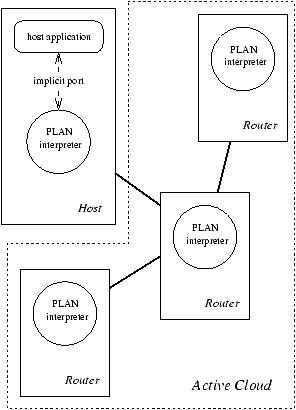
Figure 1: The PLAN network environment



svc print : 'a -> unit
svc thisHost : void -> host list
fun doit () =
(print (thisHost ()); print(" says : Hello world!\n"))
% bin/inject -help
usage : bin/inject [-v] [-val] [-p port] [-ed evalDest] [-rf routFun]
[-hf host_file] [-o outfile] <codefile>[,codefile2]...] <RB>
-v Turn on verbose mode.
-val Unmarshall and print responses as values (rather than strings).
-p Set default port. (default=3324)
-ed Set initial evaluation destination.
-rf Specify routing function.
-fid Specify flow ID. (default=0)
-hf Specify file for hostname resolution. (default=EXP_IP_ADDRS)
-o Specify file to output marshalled packet. (default=None)
The mandatory arguments are (at least one) codefile, and an integer resource
bound, or RB. The codefile argument is the name of the file (or files) that
contain the PLAN program. The RB argument specifies the initial amount of
resource (more on this later) to hand to the packet going into the network.-v option produces a verbose output. The -val option
prints output received as the string representations of PLAN values
rather than as strings; this is useful for printing the results of the
deliver service (see the Programmer's Guide). The -p option allows
you to specify the PLAN port number of the router to receive the message.
This must match the number given to -ip for some pland running
on the local machine. This also serves to set the port portion of the
identity should the thisHost local service routine be invoked during
the initial invocation (see the ping example below).4 If no -p is given, the default is 3324. The options
-ed and -rf specify the evaluation destination and routing function of the packet you are injecting. By default, the
evaluation destination (that is, the node on which the program should
evaluate) is set to the local pland5. For this reason,
the default is for this field (that is, the function that is used to help
the packet get to its evaluation destination) to be empty. Should you
decide that the first location that your program should execute is not
the local node, you would indicate where (and how to get there) with these
options. The flow id is set with -fid; this option isn't important
for now. The -hf option is used to specify the hostname file. This
file is used by the getHostByName function to map domain names to
network addresses. Finally, -o may be used to write the resulting
PLAN packet to a specified file rather than to the local interpreter. This
may be useful for `pre-creating' PLAN packets to be injected into the
network by a means other than the local PLAN interpreter.% bin/inject -p 3324 interp_tests/Helloworld.plan 10or alternatively
% bin/inject interp_tests/Helloworld.plan 10The program waits for you to give it the next input : the initial invocation. Recall that a PLAN program is a list of definitions - when the program arrives at an active host, you must specify which function to start executing and with what arguments. In the case of the Hello world program, there is only one function to execute, and it takes no parameters, so you type:
doit ();followed by a carriage return.7 Out comes the response:
[(some.ip.address,3324);<loopback>] says : Hello world!Notice that you must press Ctrl-C to get back to the command line. This is because inject waits for possible responses; since it does not know how many responses to expect, it has to wait indefinitely until told explicitly to stop. Notice that a list of names is returned as a result of the thisHost call, which differs from PLAN 2.x. This is because each PLAN router, like an Internet router, may have multiple network interfaces with one address assigned per interface. All routers will have at least two addresses: a network address and a loopback address.
% bin/inject -v -p 3324 interp_tests/Helloworld.plan 10 Using port 3324 on localhost. Initial resource bound of 10. Consuming host resolution file EXP_IP_ADDRS. Attempting to read code from files interp_tests/Helloworld.plan...done Parsing ... Enter initial invocation: doit() Initial invocation parsed. 1.1-1.6: Warning: service doit not declared. Initial invocation typechecked. Packet is 139 bytes [127][0][0][1][12][252][0][0][0][10][127][0][0][1][12][252][0][0][0][0] [0][0][0][0][0][12]defaultRoute[0][10]defHandler[0][0][0]U[0][4]doit[0] [0][0][1][2][0][4]doit[0][0][0][11][0][0][0][2][2][0][5]print[0][1][2][ 0][8]thisHost[0][0][2][0][5]print[0][1][0][3][0][0][0][21] says : Hello world![10] [(127.0.0.1,3324);<loopback>] says : Hello world!This is useful in debugging errors.
To illustrate how the print routine is working, let us briefly look at how PLAN programs are injected by a host into the active network, and how the host obtains their output. Figure 1 illustrates a hypothetical active network and a host with an application that desires to inject a PLAN program into that network. To do this, the application opens a connection to the local PLAN interpreter, and constructs and submits a PLAN packet via this connection. The PLAN packet contains the PLAN code to execute, which in our example is the ``Hello World'' code, as well some other things that we need not worry about yet. This connection also serves to pass output from the PLAN program back to the host. It is via this connection that inject receives the output generated by the print command, and it is inject that displays this output on your screen.

Figure 1: The PLAN network environment


